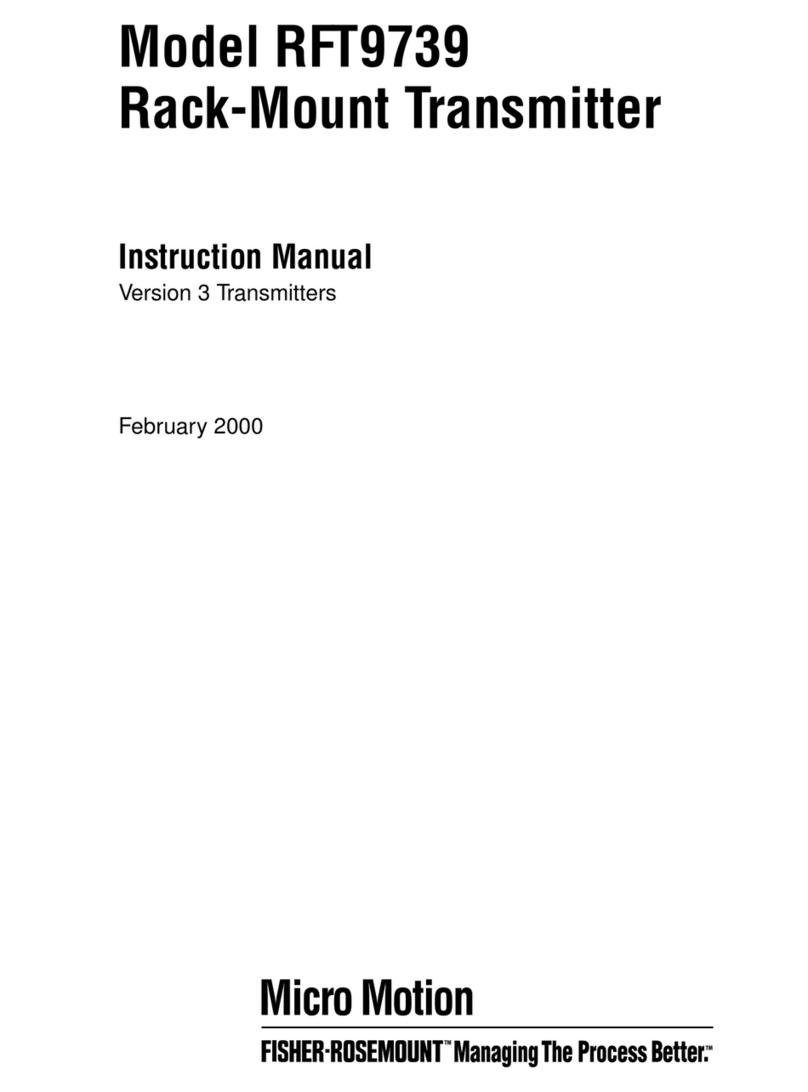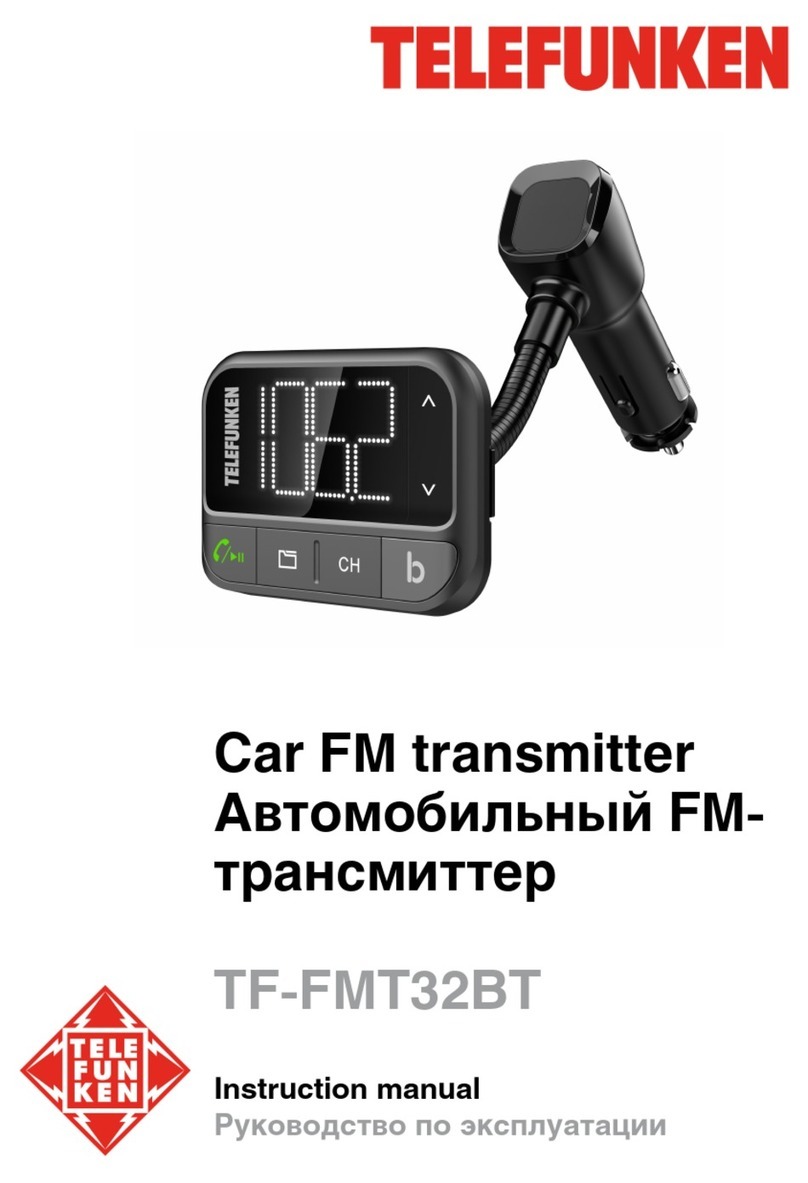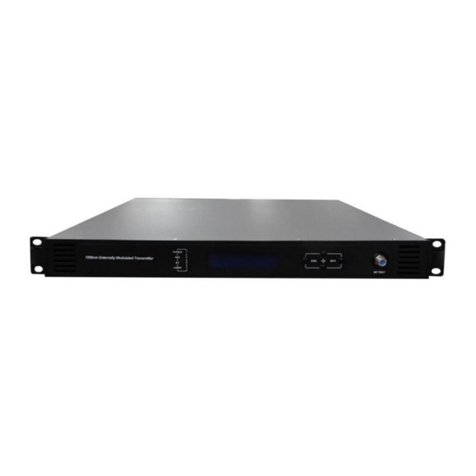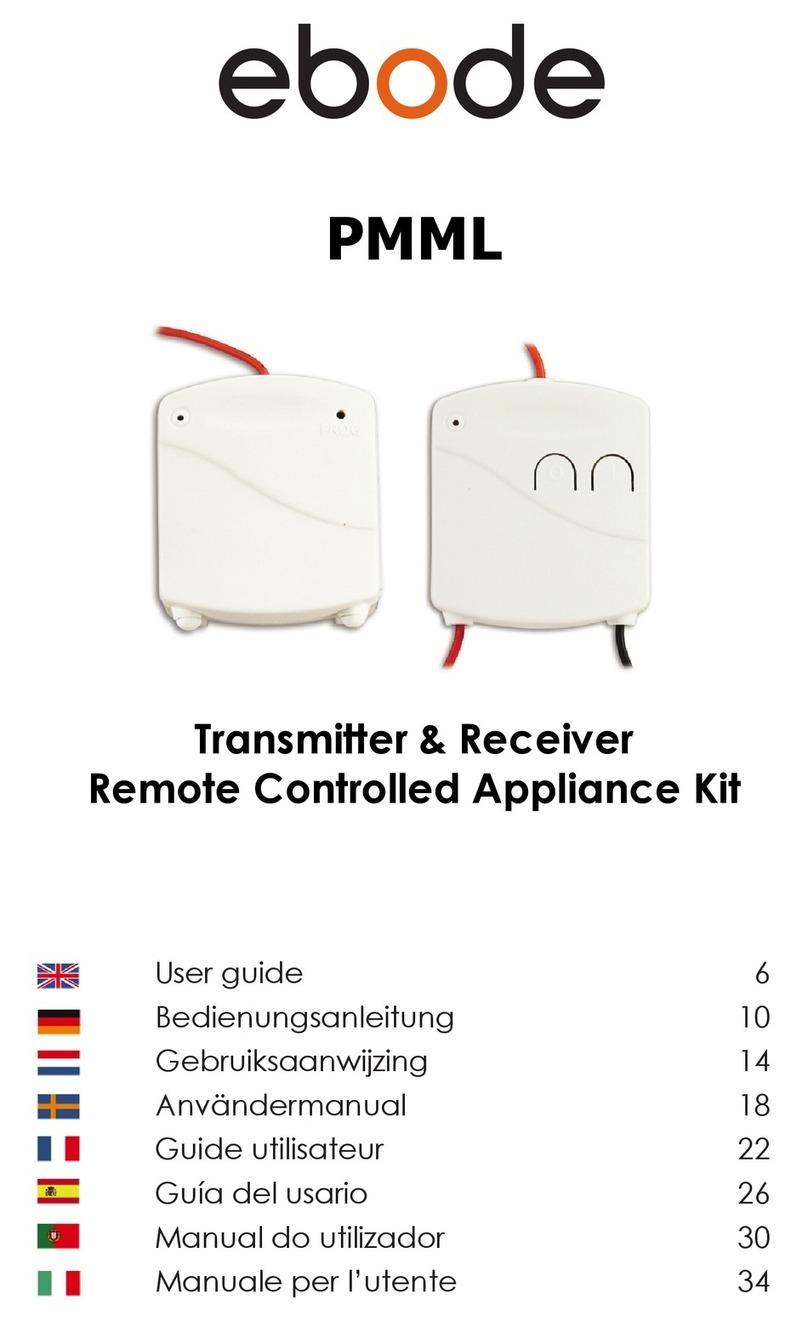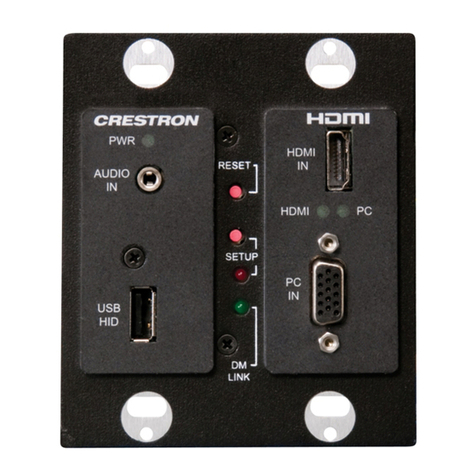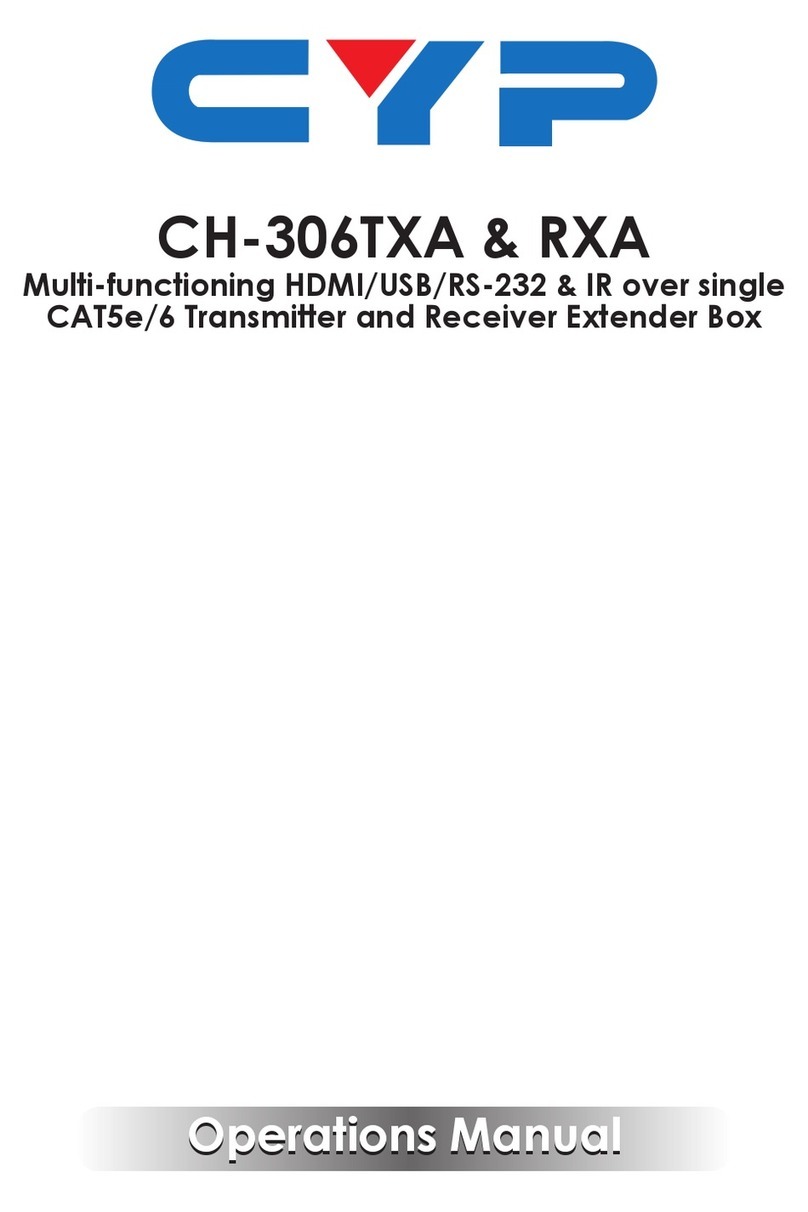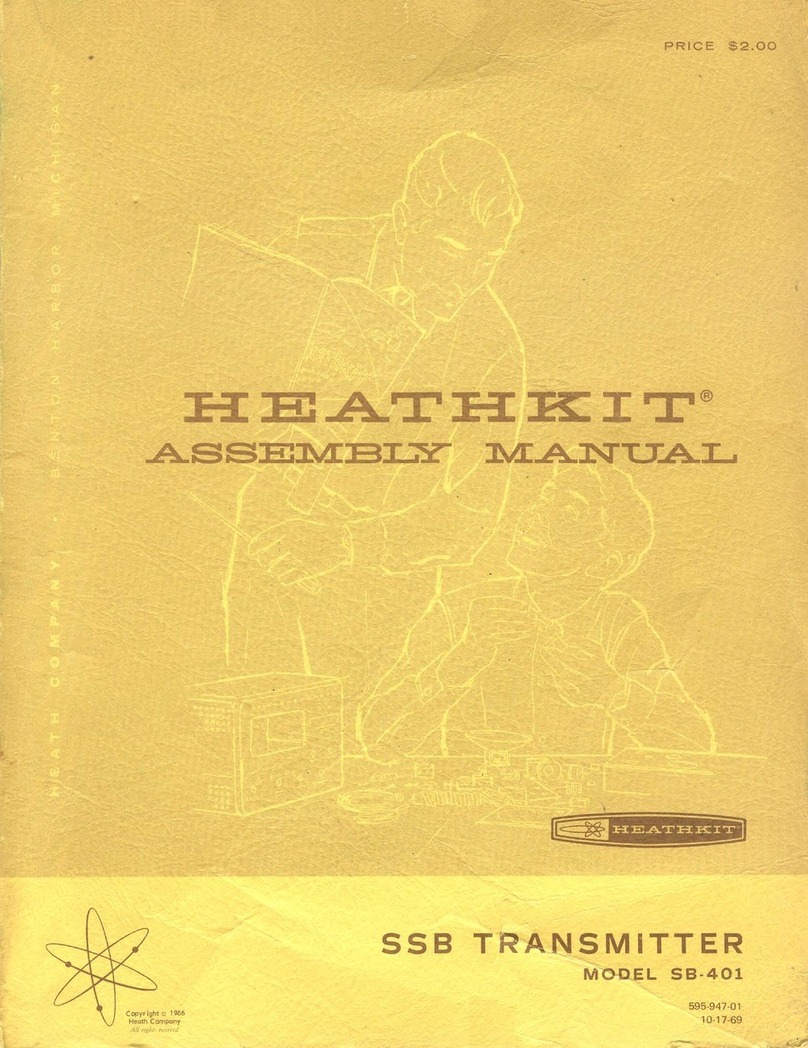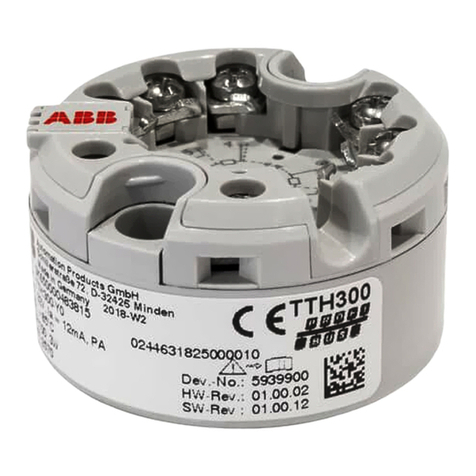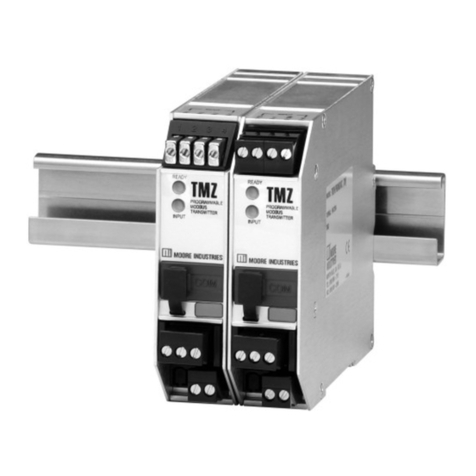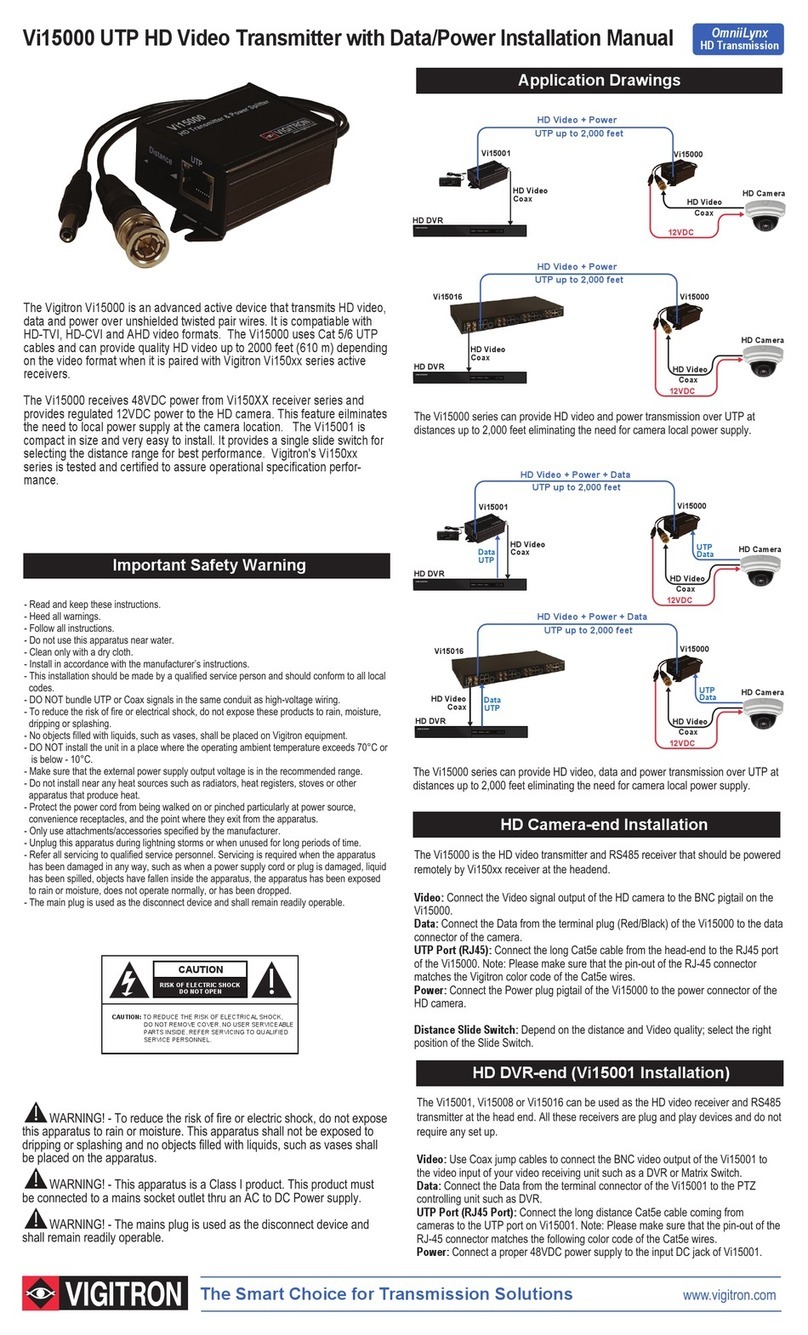Michell Instruments SF82 Series User manual

SF82
Dew-Point Transmitter
User’s Manual
97576 Issue 1
June 2019
nbn Austria GmbH

Please fill out the form(s) below for each analyzer that has been purchased.
Use this information when contacting Michell Instruments for service purposes.
Analyzer
Code
Serial Number
Invoice Date
Location of Analyzer
Tag No
Analyzer
Code
Serial Number
Invoice Date
Location of Analyzer
Tag No
Analyzer
Code
Serial Number
Invoice Date
Location of Analyzer
Tag No

SF82
For Michell Instruments’ contact information please go to
www.michell.com
© 2019 Michell Instruments
This document is the property of Michell Instruments Ltd. and may not be copied or otherwise
reproduced, communicated in any way to third parties, nor stored in any Data Processing System
without the express written authorization of Michell Instruments Ltd.

SF82 Transmitter User’s Manual
i Michell Instruments
CONTENTS
Safety ........................................................................................................................ iii
Electrical Safety .......................................................................................................... iii
Pressure Safety........................................................................................................... iii
Toxic Materials............................................................................................................ iii
Repair and Maintenance .............................................................................................. iii
Calibration.................................................................................................................. iii
Safety Conformity ....................................................................................................... iv
Abbreviations.............................................................................................................. iv
Warnings.................................................................................................................... iv
1. INTRODUCTION ..................................................................................................... 1
2. INSTALLATION ....................................................................................................... 2
2.1. Unpacking the Instrument.........................................................................................2
2.2. Preparation of the Sensor Cable ................................................................................3
2.3. Cable Connection .....................................................................................................5
2.4. Electrical Schematic..................................................................................................5
2.4.1. Electrical Boundaries ...........................................................................................6
2.4.2. Digital Communications (M12 Version Only) ..........................................................6
2.5. Transmitter Installatiom............................................................................................6
2.5.1. Sampling Considerations .....................................................................................6
2.5.2. Good Measuring Practice .....................................................................................9
2.5.3. Transmitter Mounting ....................................................................................... 12

SF82 Transmitter User’s Manual
97576 Issue 1, June 2019 ii
APPENDICES
Appendix A............................................................................................................... 16
Technical Specifications................................................................................................. 17
Product Dimensions ...................................................................................................... 19
Appendix B............................................................................................................... 22
Quality, Recycling & Warranty Information...................................................................... 23
Appendix C............................................................................................................... 24
Return Document & Decontamination Declaration ........................................................... 25
Appendix D............................................................................................................... 26
Modbus Register Map.................................................................................................... 27
Register Address........................................................................................................... 28
FIGURES
Figure 1 Connector Terminal Block Removal.........................................................................3
Figure 2 Wiring Connections ...............................................................................................3
Figure 3 Sensor Connector Installation.................................................................................4
Figure 4 Cable Connections.................................................................................................4
Figure 5 Connector Installation............................................................................................5
Figure 6 2-Wire Connection Diagram ...................................................................................5
Figure 7 Maximum Load of SF82 - Including Cable Resistance................................................6
Figure 8 Installation Location ..............................................................................................7
Figure 9 Installation Location ..............................................................................................8
Figure 10 Transmitter Mounting - Sensor Block.....................................................................9
Figure 11 Material Permeability Comparison .........................................................................9
Figure 12 Transmitter Mounting - Pipe or Duct ...................................................................12
Figure 13 Transmitter Mounting with Adapter.....................................................................14

SF82 Transmitter User’s Manual
iii Michell Instruments
Safety
The manufacturer has designed this equipment to be safe when operated using the procedures
detailed in this manual. The user must not use this equipment for any other purpose than that
stated. Do not apply values greater than the maximum value stated.
This manual contains operating and safety instructions, which must be followed to ensure the
safe operation and to maintain the equipment in a safe condition. The safety instructions are
either warnings or cautions issued to protect the user and the equipment from injury or damage.
Use competent personnel using good engineering practice for all procedures in this manual.
Electrical Safety
This instrument is designed to be electrically safe when used with the options and accessories
supplied by Michell Instruments for use with it. This instrument has been independently verified
as complying with the IEC/EN 61010 Standard for Electrical Safety for Europe and for the
equivalent 61010 standards in use in N. America. The instrument is approved for use within the
operating temperature range of -40°C to +60°C, and dependant on version, as being IP66/65.
See Specification section for full details.
Pressure Safety
DO NOT permit pressures greater than the safe working pressure to be applied to the instrument.
The specified safe working pressure is 45 MPag (450 barg / 6500 psig). Refer to the Technical
Specifications in Appendix A.
Toxic Materials
The use of hazardous materials in the construction of this instrument has been minimized. During
normal operation it is not possible for the user to come into contact with any hazardous substance
which might be employed in the construction of the instrument. Care should, however, be
exercised during maintenance and the disposal of certain parts.
Repair and Maintenance
The instrument must be maintained either by the manufacturer or an accredited service agent.
For Michell Instruments’ contact information please go to www.michell.com.
Calibration
The recommended calibration interval for this instrument is 12 months unless it is to be used in
a mission-critical application or in a dirty or contaminated environment in which case the
calibration interval should be reduced accordingly. The instrument should be returned to the
manufacturer, Michell Instruments Ltd., or one of their accredited service agents for re-
calibration.

SF82 Transmitter User’s Manual
97576 Issue 1, June 2019 iv
Where this hazard symbol appears in the following
sections it is used to indicate areas where potentially
hazardous operations need to be carried out.
Safety Conformity
This product meets the essential protection requirements of the relevant EU and US standards
and directives.
Abbreviations
The following abbreviations are used in this manual:
barg pressure unit (=100 kP or 0.987 atm) (bar gauge)
ºC degrees Celsius
ºF degrees Fahrenheit
DC direct current
g grams
in inch(es)
µm micrometer
m/sec meters per second
mA milliampere
mm millimetres
MPa megapascal
Nl/min normal liters per minute
Nm Newton meter
oz ounces
psig pounds per square inch
RH relative humidity
scfh standard cubic feet per hour
fps feet per second
T temperature
V Volts
ΩOhms
ø diameter
Warnings
The following general warning listed below is applicable to this instrument. It is repeated in the
text in the appropriate locations.

SF82 Transmitter User’s Manual
1 Michell Instruments
1. INTRODUCTION
The Michell Instruments SF82 is a loop-powered dew-point transmitter, designed to make dew
point measurements in a flowing sample. The SF82 transmitter is available with 3 different
process connections:
•5/8” - 18 UNF
•3/4” – 16 UNF
•G1/2” - BSPP
The SF82 2-wire is available with a choice of electrical connections:
•DIN 43650 Form C
•M12 5-pin

SF82 Transmitter User’s Manual
97576 Issue 1, June 2019 2
2. INSTALLATION
2.1. Unpacking the Instrument
On delivery, please check that all the following standard components are in the packing box:
•SF82 Transmitter
•Certificate of Calibration
•Connector (for sensor/cable) for MiniDIN 43650 C version only
It is recommended that all packaging is retained, in case products are returned for service or
calibration. Alternatively, if you choose to dispose of the packaging materials, ensure they are
recycled in accordance with local legislation.
The transmitter will also be supplied with a process seal, which will be fitted to the unit.
Depending on the version, this will either be a bonded seal (5/8” or G1/2” thread versions) or an
o-ring seal (3/4” thread versions).
The transmitter sensing element is protected while in transit by a cover containing a
small desiccant capsule. The connection pins are protected by a red plastic cap. None
of these plastic items are required for the operation of the transmitter. It is
recommended that the MiniDIN 43650 C connector is kept in a safe place until the
transmitter is ready for wiring.

SF82 Transmitter User’s Manual
3 Michell Instruments
Caution: when removing the central screw ensure that
the small sealing O-ring and the washer are retained on
the screw and are present during re-installation
2.2. Preparation of the Sensor Cable
The sensor cable is NOT supplied as standard. Cables can be obtained by contacting your local
Michell Instruments representative (see www.michell.com for details).
DIN 43650 Version
Cable connections to the SF82 transmitter are made via the removable connector. Removing the
central screw enables the connector terminal block to be removed from the outer housing by
using a small screwdriver to prise it clear.
The sensor cables are terminated as per the following diagram:
Note: The cable screen (see figure 2) should only be connected to a ground point at
either the transmitter installation side, or at the receiving equipment. Failure to
observe this precaution can result in ground loops and equipment malfunction.
\
Figure 2Wiring Connections
Figure 1Connector Terminal Block Removal

SF82 Transmitter User’s Manual
97576 Issue 1, June 2019 4
Always connect the 4-20 m return signal to a suitable load
(see figure 3) before the power is applied. Without this
connection, the transmitter may be damaged if allowed to
operate for prolonged periods.
M12 5-Pin Version
Cables with moulded M12 connectors are available from Michell Instruments in the following
lengths:
•0.8 m
•2 m
•5 m
•10 m
4-20 mA 2-wire
PIN 1
Modbus A
PIN 2
Modbus B
PIN 3
4-20 mA
PIN 4
Power Supply
PIN 5
0 V
The other end of the sensor cable is unterminated, for straightforward connection into the
desired monitoring system.
Function
Pin
Wire Colour
Modbus A
1
Brown
Modbus B
2
White
4 -20 mA
3
Blue
Power Supply
4
Black
0 v
5
Grey
Figure 4 Cable Connections
Figure 3 Sensor Connector Installation

SF82 Transmitter User’s Manual
5 Michell Instruments
If longer cable runs are required, off the shelf 5-pin M12 cables can be connected between the
SF82 transmitter and the cable provided by Michell Instruments.
Note: The cable screen should only be connected to ground point at either the
transmitter installation side or at the receiving equipment. Failure to observe this
precaution can result in ground loops and equipment malfunction.
2.3. Cable Connection
DIN 43650 Version
To ensure the specified ingress protection is achieved, when installing the connector, the securing
screw (with the O-ring and washer) must be tightened to a minimum torque of 3.4 Nm (2.5 ft-
lbs). The sensor cable used must be a minimum diameter of 4.6 mm (0.2”).
M12 5-Pin Version
The connector should be installed by aligning the locating pin on the transmitter with the slot
on the cable. The connector can then be pushed into place and rotated until finger tight.
2.4. Electrical Schematic
Note: The cable screen should only be connected to a ground point at either the
transmitter installation side, or at the receiving equipment. Failure to observe this
precaution can result in ground loops and equipment malfunction.
Figure 5 Connector Installation
Figure 6 2-Wire Connection Diagram
O-ring and
washer

SF82 Transmitter User’s Manual
97576 Issue 1, June 2019 6
2.4.1. Electrical Boundaries
2.4.2. Digital Communications (M12 Version Only)
Modbus RTU over RS485 communication is available on the SF82 M12, and can be used
simultaneously with the 2-wire current output. Section 2.2 describes the electrical connections to
the transmitter.
The Modbus register map can be found at the end of this manual.
2.5. Transmitter Installatiom
2.5.1. Sampling Considerations
There are two basic methods of measuring a sample with the SF82 Transmitter:
In-situ measurements are made by placing the transmitter inside the environment to be
measured.
Extractive measurements are made by installing the sensor into a block within a sample handling
system and flowing the sample outside of the environment to be measured through this system.
Extractive measurements are recommended when the conditions in the environment to be
measured are not conducive to making reliable measurements with the product.
Examples of such conditional limitations are:
•Excessive flow rate
•Presence of particulates matter
•Presence of entrained liquids
•Excessive sample temperature
Figure 7Maximum Load of SF82 - Including Cable Resistance

SF82 Transmitter User’s Manual
7 Michell Instruments
The basic considerations for each measurement type are as follows:
In-Situ
1. Dew-Point Sensor Position – will the sensor see an area of the environment that is
representative of what you want to measure?
For example, if the sensor is to be mounted into a glove box, there are three different positions
in which it could be installed – each giving a different measurement:
•Position A is on the purge inlet. In this position the sensor will confirm the dew point of the
gas entering the glove box but will not detect any leaks in the glove box itself, or any moisture
released from the work piece.
•Position B is on the gas outlet. In this position the sensor will be exposed to the gas leaving
the glove box and will therefore be detecting any moisture which has entered into the system
(e.g. ingress/leaks) or has been released by the work piece.
•Position C is in the glovebox itself, in this position the sensor will be only detecting any moisture
in its immediate vicinity. Leaks not in close proximity to the measurement point may not be
detected as this moisture could be drawn directly to the outlet.
If the transmitter is to be mounted directly into a pipe or duct, then consider that the installation
point should not be too close to the bottom of a bend where oil or other condensate may collect.
Figure 8 Installation Location

SF82 Transmitter User’s Manual
97576 Issue 1, June 2019 8
2. Gas speed – if you are planning on installing the sensor in a duct, consider how fast the
sample gas is moving through it.
•If the gas speed is very low, or occasionally static, then the moisture content through the
length (and width, if it is more than a few cm across) of the duct is unlikely to be uniform.
•Extremely high gas speeds can cause damage to the sensor. Direct insertion is not
recommended in gas speeds in excess of 10m/s (32.8ft/s).
3. Particulates – Particulates travelling at speed can cause severe and irreversible damage to
the sensor. At low velocity they can cling to the sensor, reducing its’ surface area, and
therefore response speed.
The sensor is provided with a basic level of particulate protection in the form of a sintered guard;
either HMWPE (10μm pore size) or Stainless Steel (80μm pore size). If the sample stream
contains smaller particulates than this, or generally large amounts of dust; extractive
measurement is recommended to accommodate proper in-line filtration.
4. Sample Temperature – Although the sensor can be operated at sample temperatures up
to 60°C, it is advisable to keep the sample temperature as close to ambient, and as stable as
possible to keep adsorption & desorption characteristics as consistent as possible (see section
2.5.2 Sampling Hints for more information).
Extractive
If the sensor is to be mounted into a sample conditioning system, then the above points are still
of relevance, but it is important to consider the extraction point itself – make sure that the chosen
extraction point is representative of the process, i.e. that the sample of interest is flowing past
the extraction point, and it is not being pulled from a dead volume.
Figure 9 Installation Location

SF82 Transmitter User’s Manual
9 Michell Instruments
2.5.2. Good Measuring Practice
Ensuring reliable and accurate moisture measurements requires the correct sampling techniques,
and a basic understanding of how water vapour behaves. This section aims to explain the
common mistakes and how to avoid them.
Sampling Materials – Permeation and Diffusion
All materials are permeable to water vapour since water molecules are extremely small compared
to the structure of solids, even including the crystalline structure of metals. The graph above
demonstrates this effect by showing the increase in dew point temperature seen when passing
very dry gas through tubing of different materials, where the exterior of the tubing is in the
ambient environment. If the partial water vapour pressure exerted on the outside of a
compressed air line is higher than on the inside, the atmospheric water vapour will naturally push
through the porous medium causing water to migrate into the pressurised air line. This effect
is called transpiration.
Figure 10 Transmitter Mounting - Sensor Block
Figure 11 Material Permeability Comparison

SF82 Transmitter User’s Manual
97576 Issue 1, June 2019 10
What this demonstrates is the dramatic effect that different tubing materials have on the humidity
levels of a gas passed through them. Many materials contain moisture as part of their structure
and when these are used as tubing for a dry gas the gas will absorb some of the moisture. Always
avoid using organic materials (e.g. rubber), materials containing salts and anything which has
small pores which can easily trap moisture (e.g. nylon).
As well as trapping moisture, porous sampling materials will also allow moisture vapour to ingress
into the sample line from outside. This effect is called diffusion and occurs when the partial water
vapour pressure exerted on the outside of a sample tube is higher than on the inside. Remember
that water molecules are very small so in this case the term ‘porous’ applies to materials that
would be considered impermeable in an everyday sense – such as polyethylene or PTFE. Stainless
steel and other metals can be considered as practically impermeable and it is surface finish of
pipework that becomes the dominant factor. Electropolished stainless steel gives the best results
over the shortest time period.
Take into consideration the gas you are measuring, and then choose materials appropriate to
the results you need. The effects of diffusion or moisture trapped in materials are more significant
when measuring very dry gases than when measuring a sample with a high level of humidity.
Temperature and Pressure effects
As the temperature or pressure of the environment fluctuates, water molecules are adsorbed and
desorbed from the internal surfaces of the sample tubing, causing small fluctuations in the
measured dew point.
Adsorption is the adhesion of atoms, ions, or molecules from a gas, liquid, or dissolved solid to
the surface of a material, creating a film. The rate of adsorption is increased at higher pressures
and lower temperatures.
Desorption is the release of a substance from or through the surface of a material. In constant
environmental conditions, an adsorbed substance will remain on a surface almost indefinitely.
However, as the temperature rises, so does the likelihood of desorption occurring.
Ensuring the temperature of the sampling components is kept at consistent levels is important
to prevent temperature fluctuation (i.e. through diurnal changes) continually varying the rates of
adsorption and desorption. This effect will manifest through a measured value which increases
during the day (as desorption peaks), then decreasing at night as more moisture is adsorbed into
the sampling equipment.
If temperatures drop below the sample dew point, water may condense in sample tubing and
affect the accuracy of measurements.

SF82 Transmitter User’s Manual
11 Michell Instruments
Maintaining the temperature of the sample system tubing above the dew point of the sample is
vital to prevent condensation. Any condensation invalidates the sampling process as it reduces
the water vapour content of the gas being measured. Condensed liquid can also alter the humidity
elsewhere by dripping or running to other locations where it may re-evaporate.
Although ambient pressure does not change drastically in a single location, the gas sample
pressure does need to be kept constant to avoid inconsistencies introduced by adsorption or
desorption. The integrity of all connections is also an important consideration, especially when
sampling low dew points at an elevated pressure. If a small leak occurs in a high-pressure line,
gas will leak out, however, vortices at the leak point and a negative vapour pressure differential
will also allow water vapour to contaminate the flow.
Theoretically flow rate has no direct effect on the measured moisture content, but in practice it
can have unanticipated effects on response speed and accuracy. An inadequate flow rate may:
•Accentuate adsorption and desorption effects on the gas passing through the sampling system.
•Allow pockets of wet gas to remain undisturbed in a complex sampling system, which will then
gradually be released into the sample flow.
•Increase the chance of contamination from back diffusion. Ambient air that is wetter than the
sample can flow from the exhaust back into the system. A longer exhaust tube can help
alleviate this problem.
•Slow the response of the sensor to changes in moisture content.
An excessively high flow rate can:
•Introduce back pressure, causing slower response times and unpredictable changes in dew
point
•Result in a reduction in depression capabilities in chilled mirror instruments by having a cooling
effect on the mirror. This is most apparent with gases that have a high thermal conductivity
such as hydrogen and helium.
System design for fastest response times
The more complicated the sample system, the more areas there are for trapped moisture to hide.
The key pitfalls to look out for here are the length of the sample tubing and dead volumes.
The sample point should always be as close as possible to the critical measurement point to
obtain a truly representative measurement. The length of the sample line to the sensor or
instrument should be as short as possible. Interconnection points and valves trap moisture, so
using the simplest sampling arrangement possible will reduce the time it takes for the sample
system to dry out when purged with dry gas.
Over a long tubing run, water will inevitably migrate into any line, and the effects of adsorption
and desorption will become more apparent.

SF82 Transmitter User’s Manual
97576 Issue 1, June 2019 12
Dead volumes (areas which are not in a direct flow path) in sample lines, hold onto water
molecules which are slowly released into the passing gas. This results in increased purge and
response times, and wetter than expected readings. Hygroscopic materials in filters, valves (e.g.
rubber from pressure regulators) or any other parts of the system can also trap moisture.
Plan your sampling system to ensure that the sample tap point and the measurement point are
as close as possible to avoid long runs of tubing and dead volumes.
Filtration
All trace moisture measurement instruments and sensors are by their nature sensitive devices.
Many processes contain dust, dirt or liquid droplets. Particulate filters are used for removing dirt,
rust, scale and any other solids that may be in a sample stream. For protection against liquids, a
coalescing or membrane filter should be used. The membrane provides protection from liquid
droplets and can even stop flow to the analyser completely when a large slug of liquid is
encountered, saving the sensor from potentially irreparable damage.
2.5.3. Transmitter Mounting
Once an installation location has been chosen, this point will require a thread to match the
transmitter thread. Fixing dimensions are shown in Figure 6. For circular pipework, to ensure the
integrity of a gas tight seal, a mounting flange will be required on the pipework in order to provide
a flat surface to seal against.
Figure 12 Transmitter Mounting - Pipe or Duct

SF82 Transmitter User’s Manual
13 Michell Instruments
5/8” 18 UNF Version
1. Remove the protective cover and desiccant capsule from the transmitter and retain for future
use
2. Prevent any contamination of the sensor before installation by handling the transmitter by
the main body only, avoiding contact with the sensor guard.
3. Pass the bonded seal over the 5/8”- 18 UNF mounting thread.
4. Screw the transmitter into the sampling location or sample block by hand using the wrench
flats only. DO NOT grip and twist the sensor cover when installing the sensor.
5. When installed, fully tighten using a wrench to a torque setting of 30.5 Nm (22.5 ft-lbs)
3/4” - 16 UNF Version
1. Remove the protective cover and desiccant capsule from the transmitter and retain for future
use.
2. Prevent any contamination of the sensor before installation by handling the transmitter by
the main body only, avoiding contact with the sensor guard.
3. Ensure that the O-ring is seated in the recess at the top of the transmitter body.
4. Screw the transmitter into the sampling location or sample block by hand using the wrench
flats only. DO NOT grip and twist the sensor cover when installing the sensor.
5. When installed, fully tighten using a wrench to a torque setting of 40 Nm (29.5 ft-lbs).
G1/2" BSPP Version
1. Remove the protective cover and desiccant capsule from the transmitter and retain for future
use
2. Prevent any contamination of the sensor before installation by handling the transmitter by
the main body only, avoiding contact with the sensor guard.
3. Pass the bonded seal over the G1/2" mounting thread.
4. Screw the transmitter into the sampling location or sample block by hand using the wrench
flats only. DO NOT grip and twist the sensor cover when installing the sensor.
5. When installed, fully tighten using a wrench to a torque setting of 30.5 Nm (22.5 ft-lbs)
Other manuals for SF82 Series
1
This manual suits for next models
2
Table of contents
Other Michell Instruments Transmitter manuals

Michell Instruments
Michell Instruments SF52 User manual
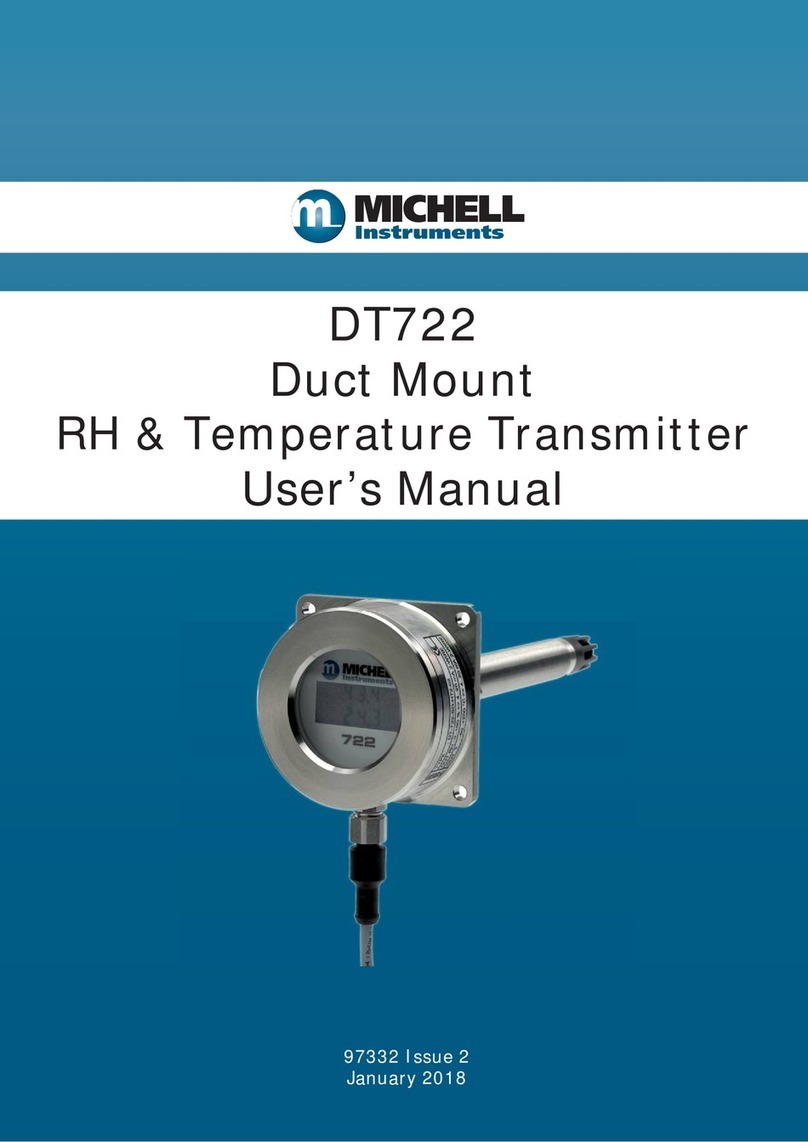
Michell Instruments
Michell Instruments DT722 User manual
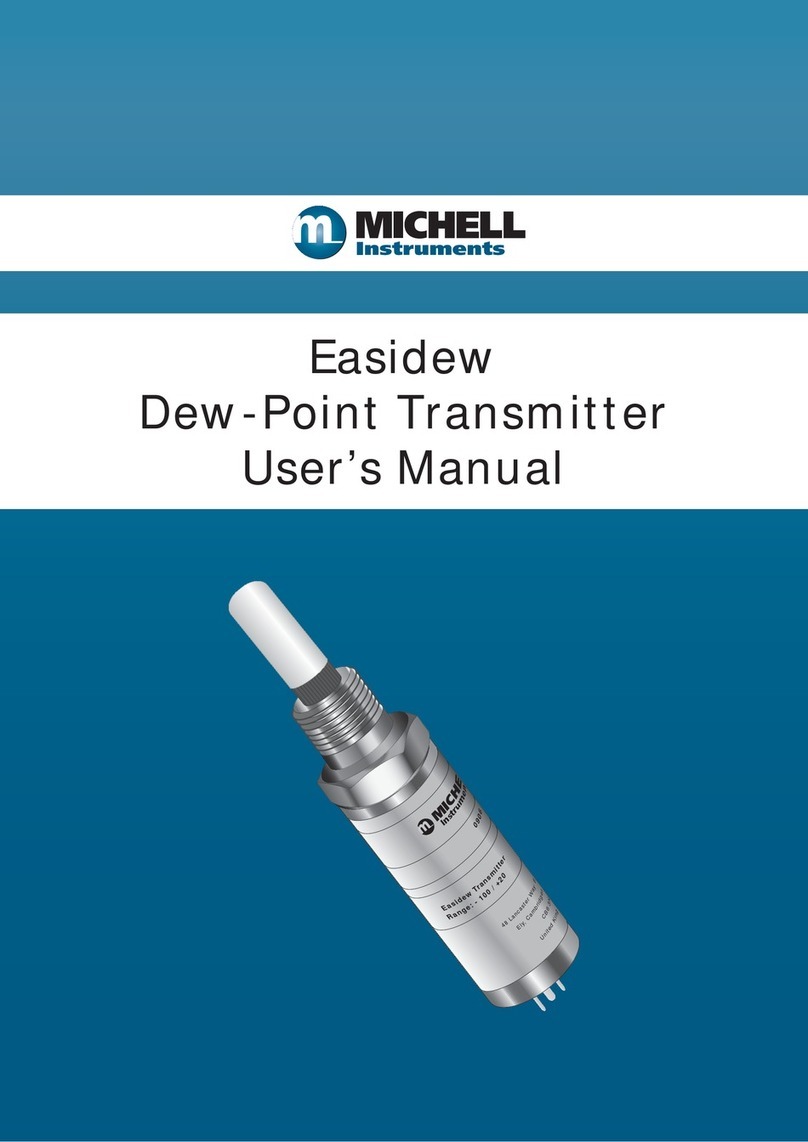
Michell Instruments
Michell Instruments Easidew User manual

Michell Instruments
Michell Instruments Easidew User manual
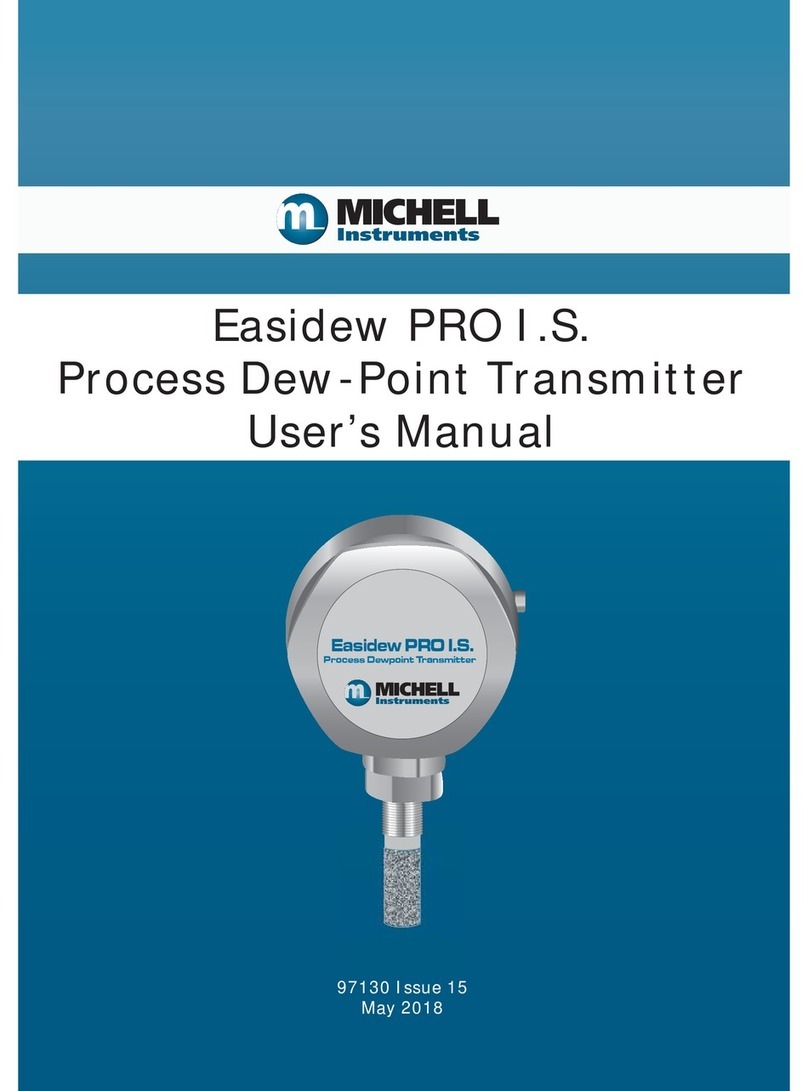
Michell Instruments
Michell Instruments Easidew PRO I.S. User manual
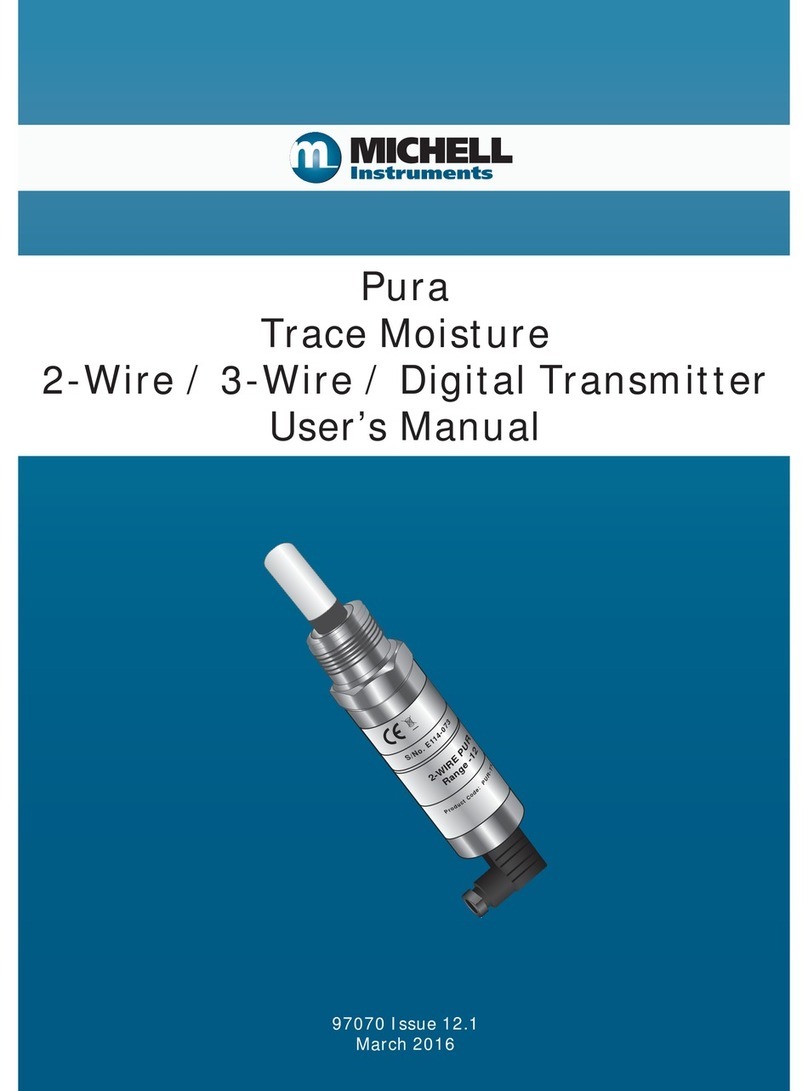
Michell Instruments
Michell Instruments Pura 2-Wire User manual
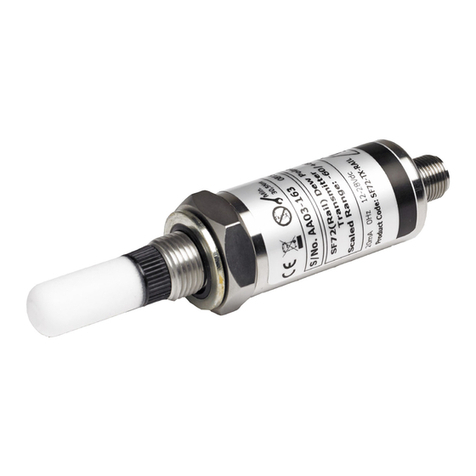
Michell Instruments
Michell Instruments SF72 User manual
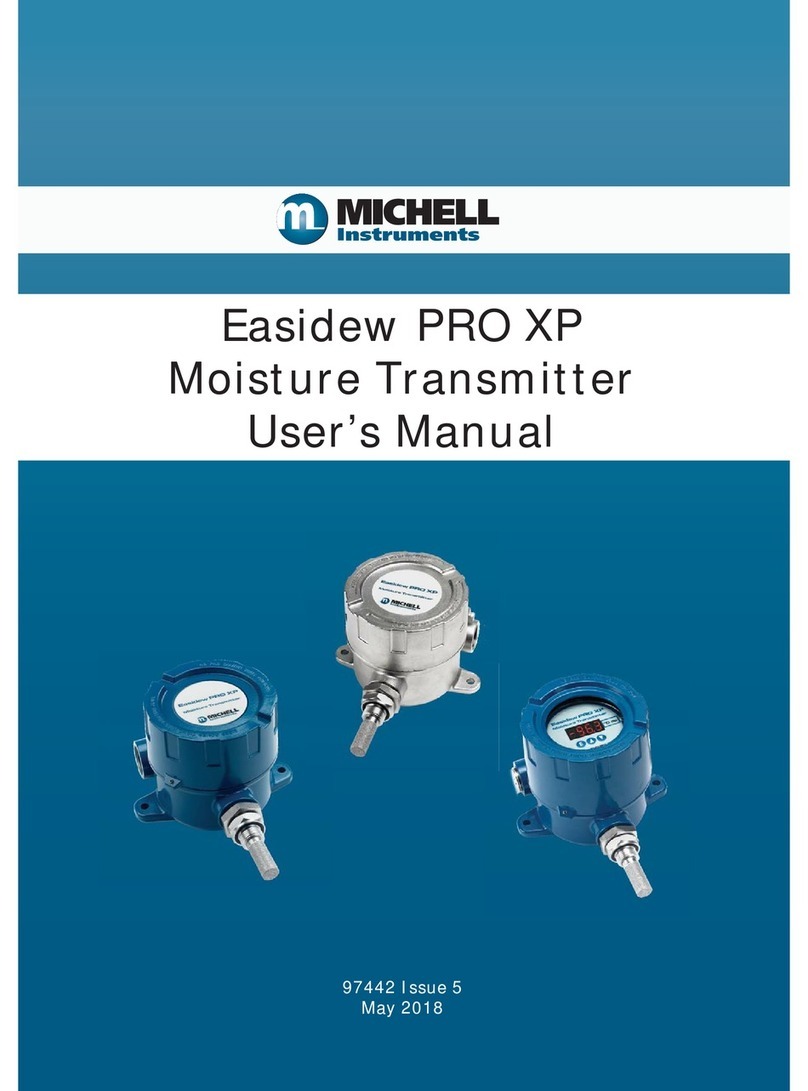
Michell Instruments
Michell Instruments Easidew PRO XP User manual

Michell Instruments
Michell Instruments Easidew I.S. User manual


